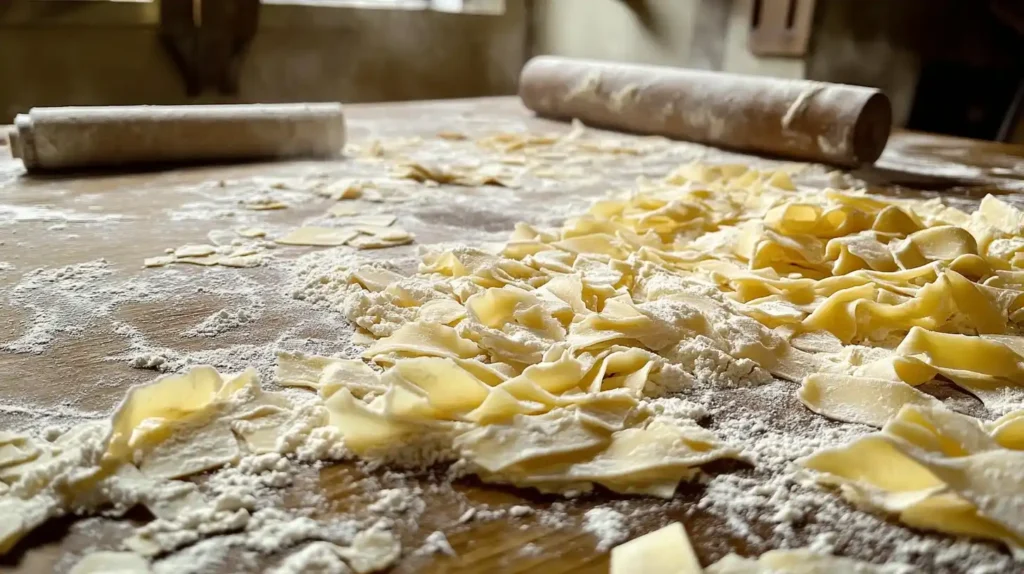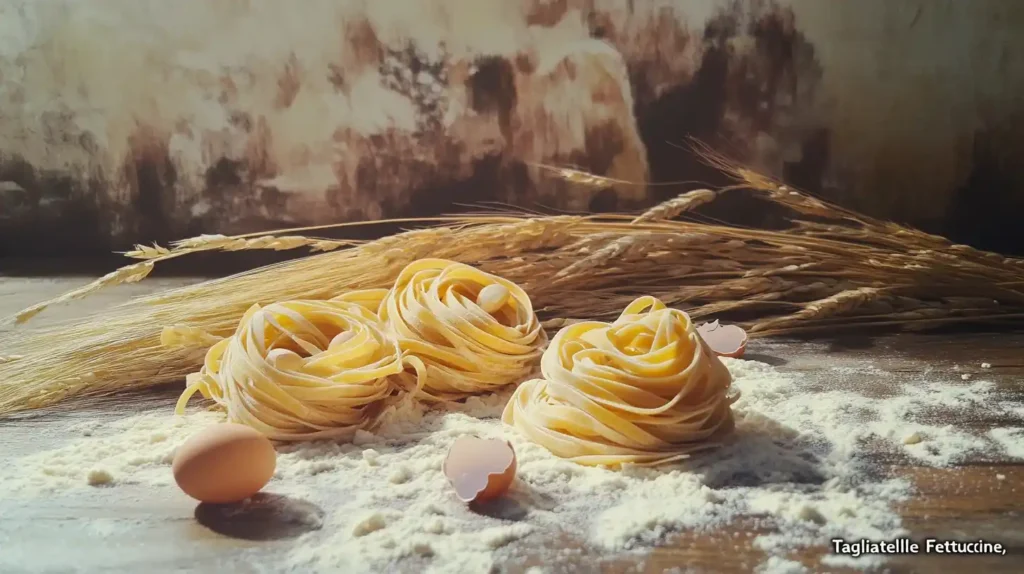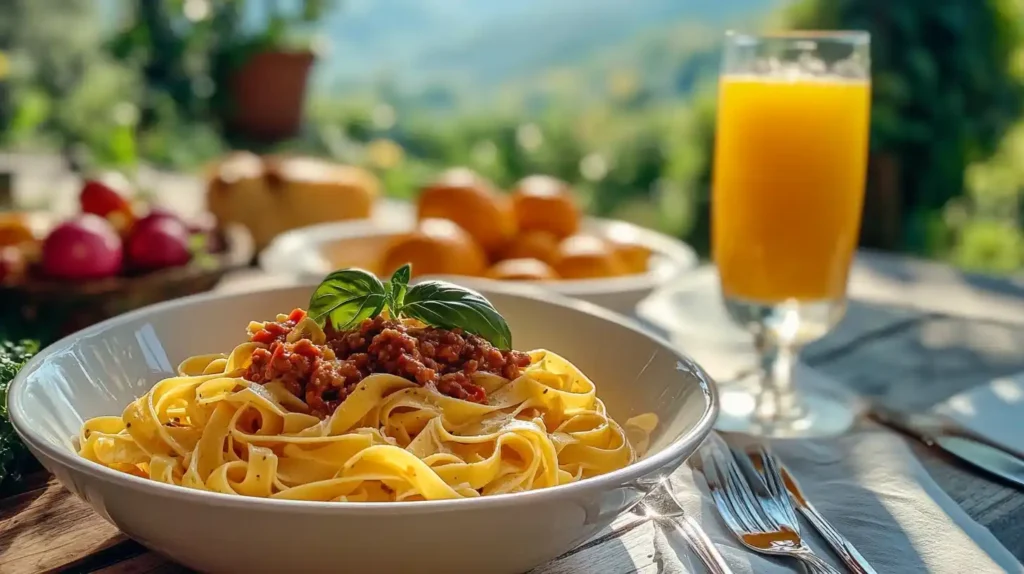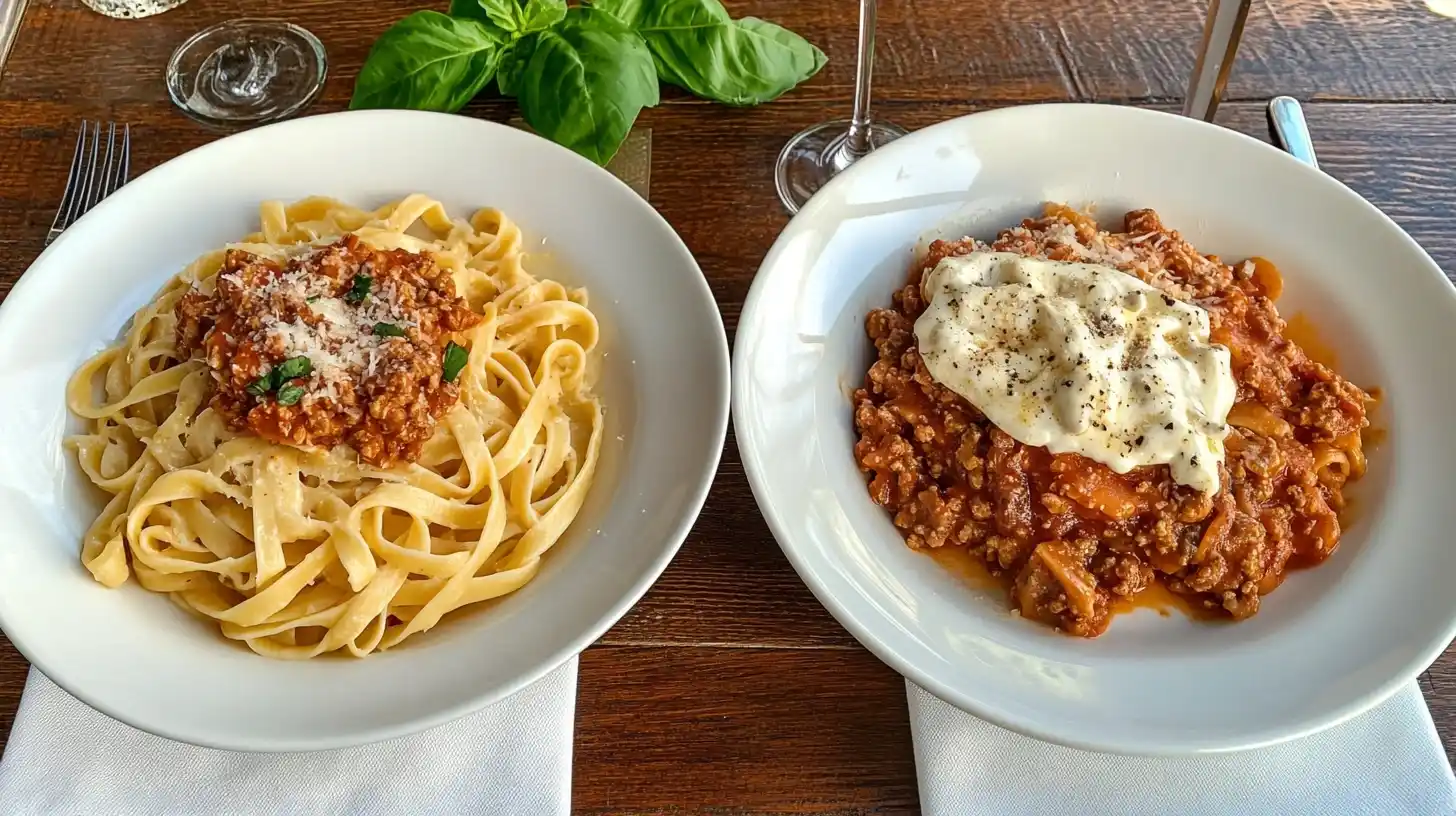Italian pasta is loved worldwide, but the variety of shapes and styles can confuse even the biggest food fans. Fettuccine and tagliatelle are two types that often confuse people. They look similar, but they aren’t exactly the same. If you’ve wondered about the difference, you’re in the right place! Let’s make it simple and clear.
Table of contents
- Where Do Fettuccine and Tagliatelle Come From?
- Visual Differences: How Do They Look Different? (fettuccine or tagliatelle comparison)
- Cooking Methods: How Are They Cooked? (fettuccine or tagliatelle comparison)
- Sauce Pairings: What Sauces Work Best? (tagliatelle vs fettuccine)
- Regional Influences: Why Do Regions Matter? (tagliatelle vs fettuccine)
- FAQs About Fettuccine and Tagliatelle
- Final Thoughts
Where Do Fettuccine and Tagliatelle Come From?
Both fettuccine and tagliatelle originate from Italy, a country renowned for its passion for pasta. While they might seem similar, their stories and origins are quite different. Knowing these details helps us better understand the dishes we enjoy.
Discover the history and preparation of fettuccine in this detailed resource, The Ultimate Guide to Fettuccine.
Fettuccine: A Rich Heritage (how fettuccine differs from tagliatelle)
Fettuccine originates from Tuscany, a region in central Italy. This pasta’s name comes from the word fettuccia, which means “little ribbon.” Tuscany is known for its hearty and rustic cuisine, and fettuccine fits perfectly into this tradition. Over time, this pasta has become a favorite worldwide, thanks to dishes like Fettuccine Alfredo.
Tagliatelle: Tradition and Taste (difference between fettuccine and tagliatelle)
On the other hand, tagliatelle originates from Emilia Romagna, a region in northern Italy. It gets its name from the Italian word tagliare, which means “to cut.” This name reflects how the pasta is made by cutting thin sheets of dough into strips. Emilia Romagna is famous for its rich meat sauces, and tagliatelle pairs wonderfully with these heavier toppings, especially ragù alla bolognese.
Knowing these details helps us better understand the dishes we enjoy. If you love exploring ingredient differences, you might also wonder: Is Fried Shallot the Same as Fried Onions? Understanding subtle variations can elevate your cooking skills.

Visual Differences: How Do They Look Different? (fettuccine or tagliatelle comparison)
At first glance, fettuccine and tagliatelle look very similar. Both are long, flat ribbons of pasta. However, there are subtle but important differences in their appearance. These differences impact how they pair with sauces and how they feel when eaten.
Width and Thickness
- Tagliatelle is usually narrower, with a width of about 6–10 mm. This narrower size makes it feel lighter when paired with rich sauces.
- Fettuccine, on the other hand, is slightly wider, giving it a sturdier texture. This extra width makes it better for heavier, cream-based sauces like Alfredo.
Presentation Style
- Tagliatelle is often served in neat nests. These rolled-up portions make it easier to serve and look visually appealing.
- Fettuccine, however, is usually laid out flat or loosely piled, showcasing its ribbon-like shape.
Fresh vs. Dried Pasta
- Both types are available as fresh or dried pasta. Fresh tagliatelle is more common, especially in northern Italy, where it is handmade using eggs.
- Fettuccine is also made fresh but is more commonly found as dried pasta in supermarkets around the world.
These visual differences might seem small, but they play a big role in how each type of pasta is cooked and served.

Cooking Methods: How Are They Cooked? (fettuccine or tagliatelle comparison)
Cooking fettuccine and tagliatelle might seem straightforward, but there are key techniques that ensure perfect results every time. The way you cook and handle the pasta greatly impacts its texture, flavor, and ability to hold sauces. Let’s explore the steps for both fresh and dried pasta and some useful tips.
1. Preparing Fresh Pasta
Fresh fettuccine and tagliatelle are prized for their soft texture and delicate taste. Here’s how to prepare them perfectly:
- Cooking Time: Fresh pasta cooks much faster than dried pasta. It usually takes 2–4 minutes in boiling water. Keep an eye on it, as overcooking can make it mushy.
- Salted Water is Key: Add a generous amount of salt to the boiling water before adding the pasta. The water should taste slightly salty, as this enhances the pasta’s flavor.
- Gently Stir: Stir the pasta occasionally to prevent it from sticking together, especially since fresh ribbons can clump more easily than dried pasta.
- Don’t Overcrowd: Cook the pasta in a large pot with plenty of water to give the ribbons room to move freely.
2. Cooking Dried Pasta (difference between fettuccine and tagliatelle)
Dried fettuccine and tagliatelle are more widely available and convenient. While they take longer to cook, the process is simple:
- Cooking Time: Most dried pasta takes 8–12 minutes, depending on the brand and thickness. Check the package instructions, but start tasting it a minute before the suggested time.
- Achieving Al Dente: For the perfect texture, cook until the pasta is al dente. This means it’s firm to the bite but not hard. Al dente pasta holds sauces better and has a more satisfying texture.
- Save Pasta Water: Before draining, save a cup of the starchy cooking water. This can be added to your sauce to adjust consistency and help it cling to the pasta.
3. Using Homemade Pasta
Making fresh pasta at home can elevate your cooking. Here’s what to keep in mind when preparing fettuccine and tagliatelle:
- Rolling the Dough: Use a pasta machine to roll the dough into thin, even sheets. Start on the widest setting and gradually move to thinner settings until you reach your desired thickness.
- Cutting the Pasta:
- For fettuccine, cut the dough into slightly wider ribbons.
- For tagliatelle, aim for narrower strips, about 6–10 mm wide.
- Drying: If you’re not cooking the pasta immediately, let it dry for about an hour. This makes it easier to handle and store.
4. Combining Pasta with Sauce
The final step in cooking fettuccine or tagliatelle is mixing it with the sauce. Here’s how to do it like a pro:
- Toss in the Sauce: Once drained, immediately toss the pasta in your prepared sauce. This helps the ribbons absorb the flavors and ensures an even coating.
- Add Pasta Water: If the sauce feels too thick, add a splash of the reserved pasta water. The starch in the water helps the sauce adhere to the pasta.
- Finish on Low Heat: For a truly blended dish, toss the pasta and sauce together over low heat for 1–2 minutes.
5. Common Mistakes to Avoid
- Overcooking: Always check the pasta a minute or two before the suggested cooking time. Overcooked pasta loses its texture and becomes soggy.
- Skipping the Salt: Unsalted water results in bland pasta, no matter how flavorful the sauce.
- Rinsing the Pasta: Never rinse pasta after cooking, as it washes away the starch that helps sauce stick.
Overcooked pasta loses its texture and becomes soggy. If you’re interested in mastering different cooking techniques, try these Chicken Sticks a crispy and flavorful dish that requires careful cooking just like pasta.
Pro Tips for Perfect Pasta
- Use a wide pot and plenty of water to ensure even cooking.
- When draining, leave the pasta slightly wet to help the sauce stick better.
- Serve immediately after mixing with the sauce, as pasta can dry out quickly.
By following these steps, you’ll achieve perfectly cooked fettuccine and tagliatelle every time. These techniques work whether you’re making a simple weekday meal or a show-stopping dinner for guests.
Sauce Pairings: What Sauces Work Best? (tagliatelle vs fettuccine)
The choice of sauce can make or break a pasta dish. While fettuccine and tagliatelle are versatile, their subtle differences in width and texture mean they work better with certain types of sauces. Here’s how to make the most of each.
Best Sauces for Fettuccine
- Cream-Based Sauces
- Fettuccine Alfredo is the most iconic pairing. The creamy, buttery sauce clings beautifully to the wide ribbons, making each bite rich and indulgent.
- Other creamy sauces, like those made with mushrooms or cheese, work equally well.
- Seafood Sauces
- The sturdy texture of fettuccine makes it a great match for light, flavorful seafood sauces. Think of shrimp scampi or a simple garlic and clam sauce.
Best Sauces for Tagliatelle
- Meat-Based Sauces
- Tagliatelle is the traditional choice for ragù alla bolognese. The narrower width helps balance the heavier, meat-filled sauce.
- It also pairs well with venison or pork ragù for a heartier option.
- Lighter Sauces
- For a less heavy meal, tagliatelle works wonderfully with truffle oil, butter, or simple tomato-based sauces. Its delicate texture allows the lighter flavors to shine.
For a less heavy meal, tagliatelle works wonderfully with truffle oil, butter, or simple tomato-based sauces. If you’re in the mood for something light yet hearty, check out this Purple Black Bean Soup Recipe.
Why Sauce Matters
- The key to pairing pasta and sauce is balance. Wider, sturdier pasta like fettuccine holds up well to heavy sauces, while narrower pasta like tagliatelle complements lighter, more delicate toppings.
Regional Influences: Why Do Regions Matter? (tagliatelle vs fettuccine)
Italy is a land of rich culinary traditions, and its regions play a significant role in shaping the identity of its food. When it comes to fettuccine and tagliatelle, their differences go beyond size and shape. Their regional roots not only define their unique characteristics but also explain the types of dishes they are typically paired with. Let’s explore why regions matter in understanding these two iconic pastas.

1. Northern Italy: The Birthplace of Tagliatelle
Emilia Romagna, located in northern Italy, is the proud home of tagliatelle. This region is often referred to as the culinary heart of Italy due to its rich and indulgent dishes. Here’s why tagliatelle thrives in this area:
- Ingredients and Climate:
The cooler climate and fertile plains of Emilia Romagna are perfect for raising livestock and growing wheat. This is why the region is known for its rich egg-based pasta and meat-filled sauces. - Perfect Pairing with Ragù:
The hearty and meaty ragù alla bolognese is the signature sauce of the region. Its robust flavors are a natural match for the delicate texture of tagliatelle. - Handmade Tradition:
In Emilia Romagna, pasta is often handmade, giving tagliatelle a soft, tender quality. This tradition continues in many households, keeping the regional culinary identity alive.
The hearty and meaty ragù alla bolognese is the signature sauce of the region. If you’re curious about other rich, meaty dishes, you might enjoy learning What is Sliced Beef Belly? and how it’s used in various cuisines.
2. Central Italy: The Land of Fettuccine
Central Italy, particularly Tuscany, is where fettuccine has its roots. The cuisine here is simpler and more rustic, reflecting the region’s agricultural heritage. This simplicity is key to understanding the role of fettuccine in Tuscan cooking.
- A Rustic Pasta for Simple Sauces:
Tuscany’s dishes often rely on a few high-quality ingredients rather than complex recipes. Fettuccine pairs perfectly with creamy sauces made from butter, cheese, and cream, such as the famous Fettuccine Alfredo. - Sturdiness for Central Italian Cuisine:
The slightly wider and firmer ribbons of fettuccine make it ideal for dishes that need a pasta sturdy enough to hold heavier sauces. - Influence of the Countryside:
Central Italy’s rolling hills and farmlands inspire dishes that are hearty yet unpretentious. This is why fettuccine is often paired with fresh herbs, mushrooms, and simple cream sauces.
3. How Regional Preferences Shape Pasta
- Cultural Identity: Each type of pasta reflects the history and resources of its region. For example, northern Italy’s focus on dairy and meat is evident in its use of creamy and hearty sauces for tagliatelle.
- Local Ingredients: The availability of fresh eggs in Emilia Romagna and central Italy’s abundant olive oil are examples of how local resources shape the pasta-making process.
- Cooking Techniques:
- In northern Italy, handmade tagliatelle is cherished for its soft texture.
- In Tuscany, fettuccine is often made using a pasta machine for consistent thickness and durability.
4. Global Influence and Modern Adaptations
While fettuccine and tagliatelle have deep regional roots, their popularity has spread far beyond Italy. In today’s globalized world, both pastas are celebrated in diverse cuisines:
- Fettuccine Alfredo: An International Star
- Although its origins lie in Italy, Fettuccine Alfredo has become a beloved dish worldwide, especially in the United States.
- Its creamy, cheesy sauce is easy to adapt and has inspired countless variations.
- Gourmet Tagliatelle
- Tagliatelle is often featured in upscale restaurants, paired with luxurious sauces like truffle cream or wild mushroom.
- Chefs around the world use tagliatelle to showcase their creativity, blending Italian tradition with modern techniques.
5. Celebrating Regional Festivals
In Italy, food is more than just sustenance it’s a celebration of life and culture. Both fettuccine and tagliatelle are often the stars of regional festivals:
- Tagliatelle Festivals in Bologna: Celebrate the pasta’s connection to ragù alla bolognese with tastings, cooking demonstrations, and competitions.
- Rustic Fettuccine in Tuscany: Local events feature fettuccine with fresh truffles, porcini mushrooms, or traditional cream sauces.
These festivals keep the regional heritage alive, allowing locals and visitors to experience the authentic flavors of Italian pasta.
By understanding the regional influences behind fettuccine and tagliatelle, you can appreciate their unique qualities and the traditions they represent. Whether you’re enjoying a bowl of creamy fettuccine Alfredo or savoring tagliatelle with a hearty ragù, you’re tasting a piece of Italy’s history.
FAQs About Fettuccine and Tagliatelle
Many people have questions about fettuccine and tagliatelle. These two pastas are similar, but understanding their differences can help you choose the right one for your next meal. Let’s address some of the most common questions.
1. What is the primary distinction between fettuccine and tagliatelle?
The main difference is the width.
- Fettuccine is slightly wider, making it sturdier and better suited for creamy, heavy sauces.
- Tagliatelle is narrower and pairs best with meat-based sauces like ragù alla bolognese.
2. Can I use fettuccine and tagliatelle interchangeably?
Yes, you can! Both pastas are versatile and can often be swapped in recipes.
- Keep in mind, however, that the sauce will cling differently due to their varying widths.
- For example, tagliatelle may not hold creamy sauces as well as fettuccine, but it will still taste delicious.
3. What is the best sauce for each pasta?
- Fettuccine: Works best with creamy sauces like Alfredo, as well as lighter seafood sauces.
- Tagliatelle: Pairs beautifully with heavier, meat-based sauces such as ragù or venison stew.
4. Are fettuccine and tagliatelle made differently?
Not really. Both are made from a simple dough of semolina flour and eggs.
- The difference lies in how they are cut. Tagliatelle is typically cut thinner, while fettuccine is cut slightly wider.
- In traditional recipes, tagliatelle is often handmade, while fettuccine is more commonly machine-cut.
5. Is one pasta healthier than the other?
The healthiness of pasta depends more on portion size and sauce than the pasta itself.
- Both fettuccine and tagliatelle have similar nutritional values when made with the same ingredients.
- Opt for lighter sauces, such as tomato-based ones, if you’re looking for a healthier meal.
FAQs like these highlight the small but meaningful differences between these pastas. By knowing them, you can create dishes that taste better and suit your preferences.
Final Thoughts
In short, fettuccine and tagliatelle may look similar, but they have their own charm. Fettuccine shines with creamy sauces, while tagliatelle pairs perfectly with rich, meaty ones. Why not try both? You’ll enjoy the delicious results. If you’re looking for a great protein pairing, you might be interested in Can You Add Grilled Chicken to Salad at Olive Garden? for inspiration on incorporating grilled chicken into your meals.

